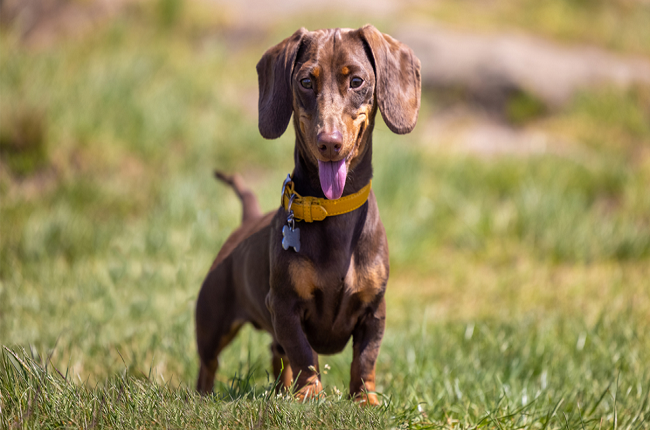
Dachshunds, with their adorable long bodies and short legs, are one of the most popular breeds in the world. However, despite their charm and unique appearance, why dachshunds are the worst breed is a topic that has been discussed among dog lovers and experts alike. While these little dogs have their loyal fan base, they are not without their challenges, and some characteristics might make them a less-than-ideal pet for certain individuals.
In this article, we’ll explore seven surprising truths that reveal why dachshunds might not be the best breed for everyone.
1. The Grooming Challenge: Why Dachshunds Are Harder to Maintain Than You Think
When it comes to grooming, many people assume that dachshunds, with their small size, would be easy to care for. However, grooming these dogs can quickly become a challenge for some owners.
High Shedding
Dachshunds come in three coat types: smooth, longhaired, and wirehaired. While the smooth coat is often assumed to be low-maintenance, it still sheds regularly. Longhaired dachshunds, on the other hand, require frequent brushing to prevent tangles and matting. Their hair grows long and can easily collect dirt, so regular baths and brushing are a must.
Regular Bathing
Because they are so close to the ground, dachshunds are prone to getting dirty during walks. Even if you have a smooth-coated dachshund, you’ll need to bathe them frequently to keep them clean and smelling fresh.
Maintenance Costs
If you opt for a longhaired or wirehaired dachshund, be prepared for a higher grooming cost. You’ll need to take them to a professional groomer every couple of months to keep their coats in good condition.
For more detailed information on grooming challenges with dachshunds, read here.
2. Health Issues: Why Dachshunds Are Prone to Serious Conditions
Dachshunds are a small breed, but their body structure—long spine and short legs—can lead to significant health problems, which make them one of the breeds most vulnerable to certain conditions.
Intervertebral Disc Disease (IVDD)
The most prominent health issue faced by dachshunds is Intervertebral Disc Disease (IVDD), a condition where the discs in their spine become damaged. Due to their elongated spines, they are more susceptible to this degenerative condition, which can lead to severe pain or even paralysis. It’s important to avoid activities like jumping off high furniture, as these can exacerbate the risk of injury.
Obesity and Joint Problems
Dachshunds are prone to obesity, which further stresses their backs and joints. Maintaining a healthy weight is crucial for this breed, as extra pounds can increase the likelihood of spine and joint issues. Regular exercise and portion-controlled meals are key to keeping your dachshund in good health.
Dental Issues
Dachshunds are also known to have dental problems. Their small mouths can result in crowded teeth, making it harder for them to maintain good oral hygiene. Regular dental checkups and teeth cleaning are necessary to prevent issues such as gum disease and tooth decay.
If you’re worried about the potential health issues, it’s important to factor in the cost and time commitment required for managing these conditions. For a more comprehensive guide to dachshund health, check out this article on health risks in small dogs.
3. Training Difficulties: Why Dachshunds Are Hard to Train
Training a dachshund can be a frustrating experience, especially if you’re a first-time dog owner. Their independent and sometimes stubborn nature makes them less responsive to training than other breeds.
Stubbornness
Dachshunds have a reputation for being stubborn, which can make training difficult. They are often described as “headstrong” and may ignore commands when they feel like it. This can be frustrating, especially when you’re trying to teach them basic commands like “sit” or “stay.”
Housebreaking Challenges
Housebreaking is another challenge for dachshund owners. They tend to take longer to house-train compared to other breeds. Part of the issue lies in their tendency to mark their territory. Consistency and patience are key when housebreaking a dachshund.
Barking and Attention-Seeking
Dachshunds are known for being vocal. They can be loud barkers, which may not be ideal in an apartment setting or if you have close neighbors. Their barking can become excessive if they feel they’re not receiving enough attention, making them a handful to manage.
Training a dachshund requires consistency, patience, and positive reinforcement. For tips on training stubborn dogs, check out this expert training guide here.
4. Separation Anxiety: Why Dachshunds Can Be Very Needy
Despite their small size, dachshunds have big personalities, and they tend to form strong bonds with their owners. This can lead to separation anxiety when they are left alone.
Emotional Attachment
Dachshunds are incredibly loyal and attached to their owners. They thrive on human interaction, and when left alone for extended periods, they may experience anxiety and distress. This attachment can lead to behavioral issues like chewing, excessive barking, and even accidents inside the house.
Not Ideal for Busy Owners
If you’re someone who works long hours or frequently leaves home, a dachshund may struggle with loneliness. They are best suited for owners who can spend a lot of time with them and offer consistent attention.
If you’re dealing with separation anxiety in your dachshund, this guide offers helpful tips on managing the condition.
5. Aggression Toward Other Pets: Why Dachshunds Can Be Territorial
One surprising truth about dachshunds is that they can be quite territorial and aggressive toward other pets, especially those smaller than them.
Hunting Instincts
Dachshunds were originally bred for hunting small animals like rabbits and badgers. As a result, they still retain strong prey instincts, which may make them less than friendly toward other pets, such as cats, birds, or even smaller dogs.
Jealousy and Territorial Behavior
Dachshunds can also become territorial and protective of their space, which can lead to conflicts with other pets in the household. If they feel that another animal is encroaching on their territory, they might become aggressive.
It’s possible to train a dachshund to get along with other pets, but it requires careful management and supervision. For advice on managing pet aggression, check out this article on behavioral training for pets.
6. Exercise Needs: Why Dachshunds Are Not Low-Maintenance Dogs
Despite their small size, dachshunds are active dogs with high energy levels. They need regular exercise to stay fit and healthy, and failing to meet these needs can result in behavioral problems.
Daily Walks and Playtime
Dachshunds need at least 30 minutes to an hour of physical exercise daily. While they don’t require as much space as larger breeds, they do need regular walks and play sessions to burn off energy.
Mental Stimulation
Dachshunds are intelligent dogs, and they need mental stimulation to stay engaged. If they are not mentally challenged, they can become bored and destructive. Puzzle toys, training sessions, and interactive play are all great ways to keep their minds sharp.
Avoiding Overexertion
Because of their susceptibility to spinal issues, it’s important to avoid over-exercising a dachshund. Intense jumping or running should be avoided to protect their back and joints.
For tips on balancing exercise and avoiding over-exertion, check out this guide on managing dachshund fitness.
7. High Veterinary Costs: Why Dachshunds Can Be Expensive to Care For
Dachshunds require frequent veterinary care, especially due to their tendency to develop health problems like IVDD and dental issues.
Medical Expenses
Due to their unique physical structure, dachshunds often require costly treatments for their spine and joints. Surgery for conditions like IVDD can run into the thousands of dollars, and ongoing care for chronic issues can add up over time.
Routine Care Costs
In addition to their medical expenses, dachshunds also need routine care such as vaccinations, dental cleanings, and flea treatments. These costs can quickly add up, especially as your dachshund ages.
Owning a dachshund can be costly in terms of medical bills and preventative care. For advice on managing pet expenses, check out this article on budgeting for pet care.
Frequently Asked Questions
1. Are dachshunds good for first-time dog owners?
Dachshunds can be difficult for first-time dog owners due to their stubbornness and training challenges. However, with patience, they can be a rewarding pet.
2. How much exercise do dachshunds need?
Dachshunds need at least 30 minutes to an hour of exercise every day, including walks and playtime.
3. Are dachshunds aggressive toward other pets?
Dachshunds can be aggressive toward smaller pets due to their hunting instincts. Early socialization and training can help.
4. Do dachshunds get along with children?
Dachshunds generally do well with children, but their stubborn nature and territorial behavior should be managed# Why Dachshunds Are the Worst Breed: 7 Surprising Truths Revealed
Dachshunds, with their iconic long bodies and short legs, have captured the hearts of many dog owners. They’re often seen as adorable, quirky pets, but why dachshunds are the worst breed is a topic that comes up among some dog owners. Although they have their charm, there are a number of challenges that make them less-than-ideal pets for certain households. In this article, we’ll explore seven surprising truths about why dachshunds might not be the perfect dog for everyone.
1. The Grooming Challenge: Why Dachshunds Are Harder to Maintain Than You Think
When it comes to grooming, many people assume dachshunds are low-maintenance because of their small size. However, grooming these dogs can be more complicated than it appears.
Shedding Issues
Dachshunds shed, whether they have a smooth, longhaired, or wirehaired coat. While smooth dachshunds are typically easier to manage, they still shed regularly. Longhaired and wirehaired dachshunds require more attention, as their coats need frequent brushing to prevent mats and tangles. If you don’t stay on top of grooming, you may end up with a dirty dog and a house full of fur.
Regular Baths and Grooming Appointments
Dachshunds are close to the ground, which means they pick up dirt and debris during walks. They may need more frequent baths than other breeds to stay clean and smell fresh. Longhaired dachshunds, in particular, require regular professional grooming to keep their coats manageable and healthy.
Increased Grooming Costs
If you choose a longhaired or wirehaired dachshund, expect to spend more on grooming services. Professional groomers will be needed regularly to manage their coats. Budgeting for this grooming routine is essential if you opt for one of these variations.
For more information on grooming challenges for dachshunds, check out this article on pet grooming basics.
2. Health Problems: Why Dachshunds Are Prone to Serious Conditions
Despite their small size, dachshunds are susceptible to serious health issues that can impact their quality of life.
Intervertebral Disc Disease (IVDD)
Dachshunds are particularly vulnerable to IVDD, a painful condition that affects the discs in their spine. This is mainly due to their long spines and short legs, which make them more likely to suffer from back problems. If not managed carefully, IVDD can lead to permanent paralysis, making spinal health a top concern for dachshund owners.
Joint and Obesity Issues
Because dachshunds have a unique body structure, they are also prone to joint problems. Their small, compact frames place additional strain on their joints, and obesity exacerbates this problem. Keeping dachshunds at a healthy weight is critical to preventing arthritis and spinal issues.
Dental Problems
Dental health can be another area of concern for dachshunds. Due to their small mouths, dachshunds may suffer from overcrowded teeth and gum disease, making regular vet visits and dental cleanings necessary.
Owning a dachshund means being prepared for potentially high veterinary bills, especially for conditions like IVDD. Learn more about common health problems in dachshunds in this detailed guide.
3. Training Challenges: Why Dachshunds Are Tough to Train
Training a dachshund can be a frustrating experience. They are often described as stubborn and independent, which can make them difficult to train, especially for first-time dog owners.
Stubbornness and Independence
Dachshunds are known for their stubborn nature. They tend to do things on their terms and are less likely to follow commands compared to more obedient breeds. Their independent streak means they may ignore you when it’s time to obey a command, making them hard to train.
Housebreaking Challenges
Housebreaking a dachshund can be time-consuming. They are not the quickest learners when it comes to toilet training, and their tendency to mark their territory may complicate the process further. Patience and consistency are key when housebreaking this breed.
Excessive Barking
Dachshunds are vocal dogs. While this can be endearing at times, their excessive barking can become a problem, particularly in a shared living space. They may bark at anything they see, and their loudness can be a nuisance to others.
Training a dachshund takes patience, consistency, and positive reinforcement. For tips on how to train your dachshund, check out this training guide.
4. Separation Anxiety: Why Dachshunds Can Be Very Needy
Dachshunds are deeply attached to their owners and can develop separation anxiety when left alone for too long.
Emotional Attachment
Dachshunds tend to form very strong bonds with their owners. They are affectionate dogs that want to be around their people as much as possible. This emotional attachment can lead to separation anxiety, where they exhibit signs of distress, like chewing or constant barking, when left alone.
Not Ideal for Busy Owners
If you have a hectic schedule or work long hours, a dachshund may not be the best choice. Their need for companionship and attention means they thrive in homes where someone is around to give them constant care and interaction.
For tips on managing separation anxiety in dogs, visit this behavioral guide.
5. Aggression Toward Other Pets: Why Dachshunds Can Be Territorial
Dachshunds can sometimes display aggressive or territorial behavior, particularly toward other pets in the household.
Hunting Instincts
Originally bred as hunting dogs, dachshunds have strong prey instincts. They may view smaller pets—such as cats, rabbits, or even smaller dogs—as potential prey, making it difficult for them to coexist peacefully with other animals in the home.
Protectiveness
Dachshunds are protective of their territory and can become aggressive if they feel another pet is invading their space. They may become territorial over food, toys, or even their human family members.
Managing this behavior requires early socialization and ongoing training. For more on managing pet aggression, visit this training resource.
6. Exercise Needs: Why Dachshunds Aren’t Low-Maintenance Dogs
Despite their small size, dachshunds are not exactly low-energy dogs. They need regular exercise to maintain their health and happiness.
Daily Exercise Requirements
Dachshunds need around 30 to 60 minutes of exercise each day. Whether it’s a brisk walk or some playtime in the backyard, they need regular physical activity to stay fit and avoid obesity. Failure to provide this can lead to behavioral problems and weight gain.
Mental Stimulation
Dachshunds are smart and need mental stimulation. Without it, they can become bored and destructive. Puzzle toys, interactive play, and obedience training can help keep their minds sharp.
Avoid Overexertion
Dachshunds are prone to spinal problems, so it’s important to avoid excessive jumping or over-exercising. Strenuous activities, like jumping from high places, should be avoided to protect their back health.
For a balanced exercise plan for your dachshund, check out this dog fitness guide.
7. High Veterinary Costs: Why Dachshunds Can Be Expensive to Care For
Owning a dachshund can be expensive, especially due to their unique health needs.
Medical Bills
Dachshunds are prone to health problems like IVDD, joint issues, and dental problems, which often require expensive treatments. Surgery for back problems can cost thousands of dollars, and ongoing care can quickly add up.
Routine Care
In addition to the medical expenses, dachshunds require regular veterinary visits for vaccinations, flea treatments, and dental care. Budgeting for these regular costs is necessary for any prospective dachshund owner.
If you’re concerned about the costs of owning a dachshund, check out this guide on managing pet expenses.
Frequently Asked Questions
1. Are dachshunds good for first-time dog owners?
Dachshunds can be challenging for first-time dog owners due to their stubbornness and training difficulties. However, with patience and consistency, they can make loyal companions.
2. How much exercise do dachshunds need?
Dachshunds require 30 to 60 minutes of exercise daily. Regular walks and playtime are essential to their physical and mental well-being.
3. Are dachshunds aggressive toward other pets?
Dachshunds may be territorial and aggressive toward other pets, especially smaller animals. Early socialization and supervision are key to managing this behavior.
4. Do dachshunds get along with children?
Dachshunds can be great with children, but their protective and sometimes independent nature means that supervision is necessary.
In conclusion, while why dachshunds are the worst breed might seem harsh to some, understanding the challenges of owning a dachshund can help potential owners make an informed decision. With proper care, training, and attention to their specific needs, dachshunds can be wonderful companions. However, they are not a low-maintenance breed, and it’s important to be prepared for the commitment involved in caring for them.
You May Also Like:
How Long Until 3:30: 7 Crucial Tips for Instant Time Tracking







